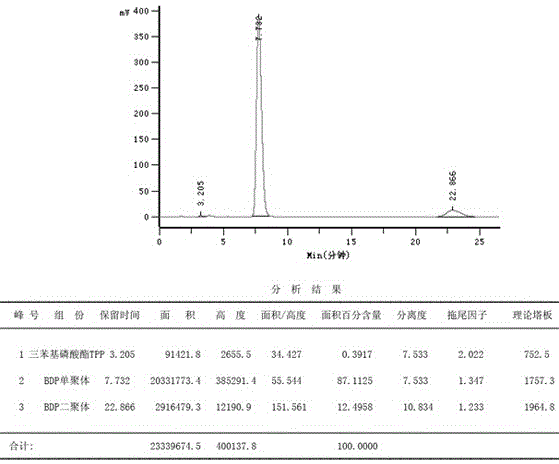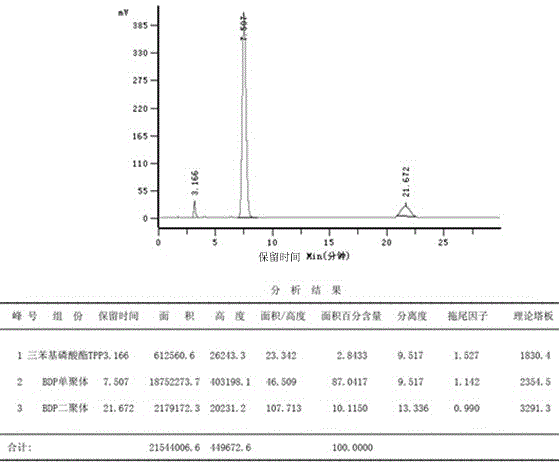Industrial preparation method of bisphenol A bis(diphenyl phosphate) with low triphenyl phosphate content
A technology of phenyl phosphate polycondensation and triphenyl phosphate, which is applied in the field of industrial preparation of bisphenol A phenyl phosphoric polycondensate, can solve the problem of physical properties affecting the flame retardancy of products, molded product defects, and easy occurrence Volatilization, seepage and other issues
- Summary
- Abstract
- Description
- Claims
- Application Information
AI Technical Summary
Problems solved by technology
Method used
Image
Examples
preparation example Construction
[0033] The industrialized preparation method of bisphenol A phenyl condensed phosphate with low triphenyl phosphate content of the present invention comprises the following steps:
[0034] 1) Put phosphorus oxychloride 4-10 times the molar amount of bisphenol A into the reaction kettle equipped with bisphenol A solid twin-screw feeder, phosphorus oxychloride reflux and vacuum distillation device, and hydrogen chloride gas absorption device, Add a catalyst with 0.2-1% of the weight of phosphorus oxychloride, raise the temperature to 90-100°C, use a twin-screw feeder to continuously add bisphenol A accounting for 90-99% of the total amount of bisphenol A, and after the addition is completed, the temperature is 100-110°C Insulation under heat until the reaction is complete; the catalyst is anhydrous magnesium chloride, anhydrous aluminum trichloride or anhydrous titanium tetrachloride;
[0035] 2) Switch the system to a phosphorus oxychloride distillation device equipped with a p...
Embodiment 1
[0045] 1) Put 6060 kg (39.48 kilomoles) of phosphorus oxychloride into a 6300L reaction kettle equipped with bisphenol A solid twin-screw feeder, phosphorus oxychloride reflux and vacuum distillation device, and hydrogen chloride gas absorption device, and add catalyst anhydrous Magnesium chloride 20 kg, heat up to 97°C, use a twin-screw feeder to continuously add 1425 kg (6.25 kilomoles) of bisphenol A, which accounts for 95% of the total bisphenol A, and add it in about 6 hours, then keep warm at 100-110°C for about 2 hours until the reaction is complete;
[0046] 2) Switch the system to a phosphorus oxychloride distillation device equipped with a phosphorus oxychloride distillation rate measuring device, and gradually increase the distillation temperature and vacuum degree. After about 5 hours, the temperature rises to about 135°C and the vacuum degree reaches 0.096Mpa. And when the phosphorus oxychloride distillation rate is less than 10ML / min, the phosphorus oxychloride d...
Embodiment 2
[0051] 1) Put 6060 kg (39.48 kilomoles) of phosphorus oxychloride into a 6300L reaction kettle equipped with bisphenol A solid twin-screw feeder, phosphorus oxychloride reflux and vacuum distillation device, and hydrogen chloride gas absorption device, and add catalyst anhydrous 20 kg of aluminum trichloride, heat up to 100°C, use a twin-screw feeder to continuously add 1350 kg (5.92 kilomoles) of bisphenol A, which accounts for 90% of the total bisphenol A feed, and add it in about 6 hours, and then add it at 100-110°C Keep warm for 2 hours until the reaction is complete;
[0052] 2) Switch the system to a phosphorus oxychloride distillation device equipped with a phosphorus oxychloride distillation rate measuring device, and gradually increase the distillation temperature and vacuum degree. After about 5 hours, the temperature rises to 140°C and the vacuum degree reaches 0.093Mpa, and When the phosphorus oxychloride distillation rate is less than 10ML / min, the phosphorus oxy...
PUM
 Login to view more
Login to view more Abstract
Description
Claims
Application Information
 Login to view more
Login to view more - R&D Engineer
- R&D Manager
- IP Professional
- Industry Leading Data Capabilities
- Powerful AI technology
- Patent DNA Extraction
Browse by: Latest US Patents, China's latest patents, Technical Efficacy Thesaurus, Application Domain, Technology Topic.
© 2024 PatSnap. All rights reserved.Legal|Privacy policy|Modern Slavery Act Transparency Statement|Sitemap



